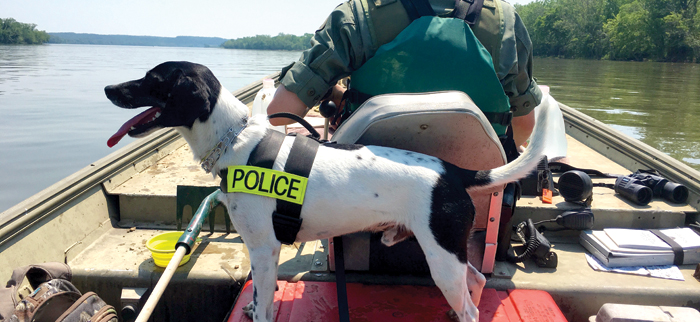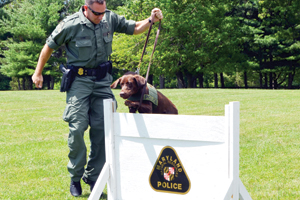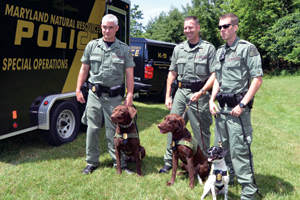Taking a Bite Out of Crime: Maryland Natural Resources Police K-9 unit

Cpl. Lillard and Rider patrolling the Potomac River; department photos
Sometimes, the good guys arrive on four paws.
Maybe they’re asked to find a hiker, lost and cold, in the woods. Perhaps, it’s to look for a weapon used in a crime and tossed into an overgrown field. Or it could be to zero-in on wildlife illegally shot by a poacher and hidden away from prying eyes.
Whatever the assignment, the five dogs of the Maryland Natural Resources Police K-9 unit perform. Their reward for a job well done is a scratch between the ears, words of praise and a few minutes with a favorite squeaky toy.
They are part of Maryland’s oldest statewide police force. And, yes, they do wear badges.

Cpl. Lowe and Harbor training
A program rejuvenated
With the retirement of Sgt. Lisa Nyland, who founded the K-9 unit in 1994, and the pending retirement of Cpl. Curt Dieterle, the squad of officers and dogs is entering a new era.
Sgt. April Sharpeta and Cpl. Devin Corcoran comprise the new leadership team. They were joined June 17 by three new handlers: Officer First Class Jake Coxon, Cpl. Ben Lillard and Cpl. Brad Lowe. In another signal of change, the handlers and dogs were trained in-house rather than out of state, thanks to a generous contribution from the Humane Society of the United States.
The new arrangement saves travel time and money, and keeping things local means that Maryland can tailor training to our unique geography and animal species.
Becoming a team
Maryland’s dogs and handlers receive 400 hours of training before they are certified to work as a law enforcement team. They train together several times a year to stay sharp. The agency needs to know that it can count on them in life-or-death situations while judges want assurance that evidence presented in court passes the sniff test.
In an outdoors filled with a bouquet of aromas, each of the dogs is an expert in scents that set its nose twitching, from wild turkeys and brown trout to gunpowder and human remains. With a sharp bark, they tell officers to look here instead of there, saving precious time and resources in situations where often every moment counts.
For Lillard, the decision to apply for the K-9 unit was a natural progression. “I love dogs, have always had dogs and grew up around them. My first job in high school was at a veterinarian clinic. I thought it would be a great way to merge something I love outside of the job.”
Lowe saw the K-9 unit as a way to improve enforcement efforts. “I was looking for a way to enhance my patrols as well as help other officers in the field. I was looking for that something extra I could do, and K-9 was a perfect fit.”

Officer Coxon and Ruckus, Cpl. Lowe and Harbor, Cpl. Lillard and Rider
Meet the dogs
The three dogs selected for the unit got a new lease on life. Ruckus—who is part Chesapeake Bay retriever—and terrier-hound mix Rider came from the Humane Society of Harford County shelter. Harbor, a Lab mix, came from the Humane Society of Kent County shelter.
“These pound puppies, unwanted by others, are now an integral part of our agency,” says superintendent Col. Robert K. “Ken” Ziegler Jr. “I couldn’t be more pleased to have them as a part of our enforcement team.”
And make no mistake: these are working dogs.
Dieterle’s partner, Blu, earned an award from the American Kennel Club for finding a woman lost in mountainous terrain. Nyland’s first partner, a yellow shelter lab named Jesse, found a newborn baby in a trash bin, a Boy Scout missing for several days in Dorchester County and worked a six-day shift in the charred rubble of the Pentagon after the terrorist attacks of 9/11. In 2008, her dogs, Liberty and Patriot, teamed up to crack a 2-year-old Somerset County murder case by finding evidence once missed. Recently, Sharpeta’s partner, Badger, located a murder weapon.
Since their graduation, the new teams have settled into their beats. Coxon and Ruckus cover the southern region of the state. Lillard and Rider patrol the central region. Lowe and Harbor work in western Maryland.

Habor getting his badge
Learning the ropes
A terrier mix, Rider doesn’t look like your typical police dog, a point Lillard acknowledges with a grin.
“I was a little reluctant when we received our partner assignments,” Lillard says. “But he showed me pretty quickly that size and breed are not barriers for a scent K-9. It’s all about the nose and the drive. He’s a high-energy, very smart little guy, and he keeps up with all our labs like he’s one of them.”
Lillard hopes his diminutive partner can be a role model for other police agencies—especially those on tight budgets—to consider the potential of mixed breeds and shelter dogs as K-9s.
Lowe also has high hopes for Harbor, perhaps the youngest of the pack.
“The biggest surprise so far is how Harbor took to me and my family since I only had him one week before training began,” he says. “The dogs are still learning but they are good at what they do. With time and experience, they will only get better.”
All five K-9 officers have patrol responsibilities in addition to being available for special tracking assignments. That means juggling a normal shift and dog training exercises. Still, they see the potential.
“The dogs are all relatively young and none of the handlers are near retirement. So I think we have a lot of time to continue building bonds with our partners, refining our skills, and making this a real standout program,” Lillard says. “There aren’t a ton of conservation-focused K-9 units out there, so we have the potential to really build on what we have and make a name for ourselves.”
Article by Candy Thomson—Natural Resources Police public information officer.
Appears in Vol. 19, No. 4 of the Maryland Natural Resource magazine, fall 2016.


 1-888-373-7888
1-888-373-7888 233733
233733